Subscribe to blog updates via email »
How I reduced my microplastics exposure (without going crazy)
Microplastics are so ubiquitous that the common choices are to either surrender to the inevitable exposure or drive yourself crazy trying to eliminate every possible source – which is impossible because microplastics are in our bodies from birth, and a main source of exposure is the air we breathe.
I recently started trying to reduce my microplastics exposure. Here’s what I’ve changed.
My TL;DR for microplastics reduction
- Start with what goes in your body
- Avoid plastic when it’s wet, hot, or on your skin for hours (including polyester!)
- The more processed and mass-produced, the more likely it’s contaminated (including supplements)
- Don’t be dumb: Swap the easy and obvious ASAP
- Don’t panic: No way to eliminate exposure
My microplastics reduction philosophy: don’t be dumb
You’ll never eliminate all microplastics exposure, but there’s no need to be dumb. If there is an alternative that’s just as good, not terribly expensive, and will expose you to fewer microplastics, might as well use it instead.

WANT TO WRITE A BOOK?
Download your FREE copy of How to Write a Book »
(for a limited time)
4 principles for microplastics reduction
Because of the expense and logistical issues (I live in South America), I didn’t test my intervention with a microplastics blood test. Instead, I made decisions guided by principles of what leads to microplastics exposure.
- Proximity: If it goes inside your body, such as by eating or drinking, it’s a high priority.
- Heat: If it’s heated and touches your food or drink, or touches your body, it’s a high priority.
- Duration: If it spends a lot of time next to your body, it’s a high priority.
- Level of Processing: If it’s a highly-processed food, made at large-scale, it should be eliminated or reduced.
That last one is tricky, because “processed” can have a broad definition. Olive oil, which I changed, is technically a processed food. Supplements are highly-processed.
I also asked myself, Would this change significantly reduce my quality of life? If yes, I’m less likely to make the change.
What I’ve changed
I’m making incremental changes as I go. I let my old stuff wear out first, when possible, instead of buying new and throwing it away.
Here’s what I’ve changed.
Water

Water goes in your body. Lots of it. Water from plastic bottles is high in microplastics, and even tap water may have microplastics.
I now distill all my drinking water with a water distiller. The water only comes in contact with stainless steel, glass, and a little bit of silicone.
This is what gets distilled out of one gallon of my tap water.
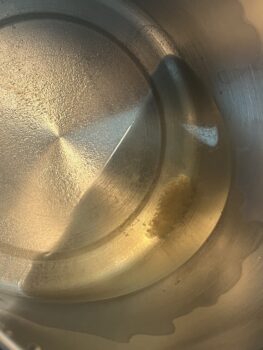
My TDS meter shows 1 ppm. That means one part per million of something (microplastics or otherwise). My tap water is 55 ppm, and I’ve tested in Scottsdale, Arizona, where it was over 300 ppm.
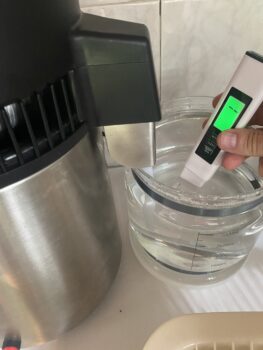
I chose not to go with reverse osmosis because the process wastes a lot of water, it can leak and flood your house, and the water touches plastic components.
Distillation removes minerals, but as a keto-not-by-choice practitioner, I already supplement with electrolytes, such as sodium, potassium, magnesium, and calcium. (Though I wonder how many microplastics are in my supplements!)
Water Bottle
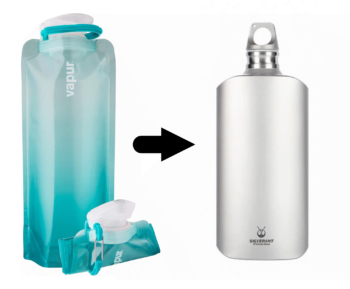
I mostly use my water bottle on the golf course, where it can get heated by the sun, and leach microplastics and chemicals. I used to use a collapsible plastic water bottle by Vapur, but I changed to a titanium water bottle by SilverAnt.
Titanium doesn’t have the negative health effects of, say, aluminum. But it’s still very light, unlike stainless steel – which is important for everyday carry.
It might seem crazy to spend like $100 on a water bottle, but I frequently replaced my Vapur, so that added up, too.
Olive Oil
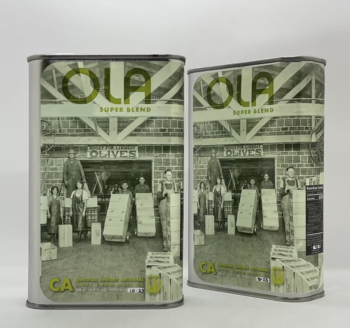
I eat a few tablespoons of olive oil a day. You might think that buying olive oil in glass bottles would be safe, but one study found olive oil packed in glass had just as many microplastics as packed in plastic.
Microplastics probably get in olive oil during production, storage, and transport.
Olive oil and microplastics apparently love each other. Olive oil is used in studies to catch microplastics to measure how many there are. Crazy!
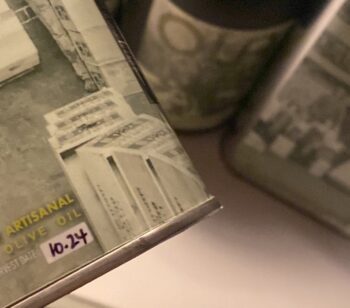
I now order directly from a small California farm. Their harvest date is very recent, and is handwritten on the label, so I’m assuming their production etc. has low exposure.
This olive oil is about four times the price of what I was buying at the supermarket, but it’s a small proportion of my food bill, and I swear I can feel the polyphenols at work when I eat it.
Retainer
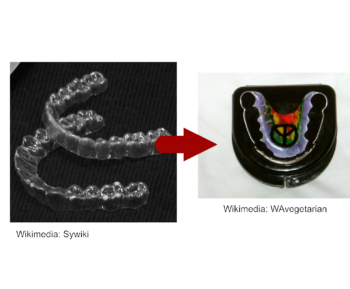
My retainer is in my mouth all night, every night. My all-plastic (“Essix”) one needed replacing, so I switched to the Hawley-style retainer, which is wire with acrylic.
Hawley retainers are acrylic, which isn’t perfect, but doesn’t contain BPA, which soft retainers leech. Soft retainers and aligners leech BPA.
I actually find the wire retainer more comfortable.
I could of course avoid exposure from the acrylic in my retainer by going back to having crooked teeth, but, no thanks.
Food Storage

I’m gradually replacing my plastic food containers with 100% silicone containers from Sustainable Containables.
I’m wary of random products on Amazon that claim to be 100% silicone, but are colored. Sustainable Containables are certified by the LFGB – a European standard more rigorous than the FDA. Sustainable Containables even sent me their lab reports, upon my request.
Polypropylene, or “food safe” plastic, doesn’t contain BPA or other bisphenols, but still contaminates food when heated. Glass is probably the best options, but we needed these containers to withstand travel.
Workout Clothes
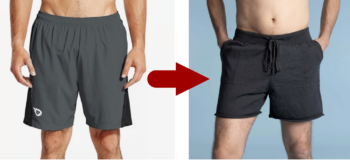
Your workout clothes get hot and endure friction. This, next to your genitals, and plastics, such as polyester, disrupt your hormone production.
I started with the shorts. I’m currently wearing organic merino wool shorts from Rawganique. They aren’t a home-run, as I do find the wool kind of itchy, and they’re a bit too short. But I paid $90 for them, so a change will have to wait.
I’d like to try cotton instead, though I often wear the cotton underwear I’m about to mention, underneath.
I want to change to an organic cotton workout shirt, next.
Underwear

Ladies are often advised to wear cotton underwear, but all that heat and friction may also absorb microplastics into your nuts.
I bought one pair of Rawganique organic cotton boxer briefs and love them. I’ll be gradually replacing with these as my undies wear out.
Most my underwear is already cotton, but I went the extra mile to get organic cotton, with gentle processing, and plant-based dyes – thus Rawganique.
Bedside Drinking Glass
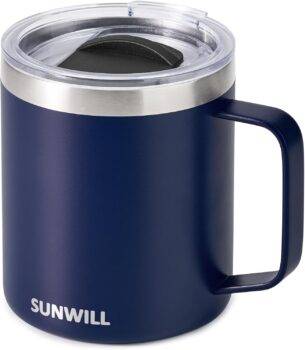
I keep a glass of water on my nightstand. I used to use a plastic one, to avoid breaking it in the dark. Now I use a stainless steel mug.
Sardines
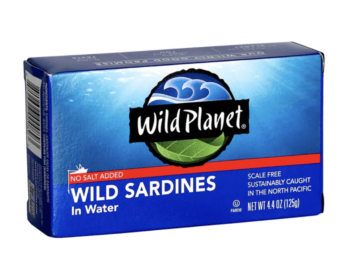
If I was really paranoid, I wouldn’t eat seafood at all. The ocean is riddled with microplastics. But, they’re a great protein snack, high in Omega 3s.
I eat Wild Planet sardines, packed in water, with no added salt. These sardines are from the North Pacific, which is on the cleaner side.
Wild Planet also seems like an upstanding company in that they advertise that no BPA is added to their cans, but refuse to call their products “BPA-free”, because BPA is in everything.
(Bonus tip: BPA is only the bisphenol the FDA says is bad. But they’re all bad. So “BPA-free” is kind of meaningless.)
Why do I go salt-free, packed in water? Because sea salt, which is usually added, is high in microplastics, and olive oil, as I’ve talked about above, is too.
So I drain the can, plate it, and add my own pink Himalayan salt and small-batch olive oil.

Dish Sponges
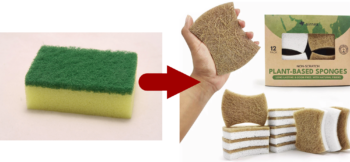
Synthetic sponges degrade all over your dinnerware. So, I switched to plant-based sponges, made of coconut and cellulose.
They definitely don’t work up a lather, scrub as aggressively, or last as long as synthetic sponges, but we’ve been using them for months and they’re good enough.
Future changes
- Bedding: Organic cotton sheets would be ideal, but that’s not a thing in Colombia, and bed sizes are different here.
- Sleep Mask: I tried Rawganique’s sleep mask, but it doesn’t have eye cups, so still using my favorite, chemical-smelling, sleep mask from Amazon.
- Socks: I sweat in them, especially walking the golf course. But I’m skeptical cotton could hold up.
- Slippers: I wear slippers most of the day. Eyeing Rawganique’s house shoes.
- Cooking Utensils: I use a plastic spatula and have no good excuse. I also have analysis paralysis over replacing my plastic cutting board.
Microplastics resources
- Andrew Huberman talks to microplastics and reproductive health researcher Dr. Shanna Swan: The actions I took and principles I followed are mostly inspired by this conversation, which also covers evidence of health effects of microplastics exposure. Dr. Swan is in her 80s and you’d never guess it.
- Plasticlist provides test results of plastics-chemicals found in various foods. (Use with caution as they are low-sample-sized not-peer-reviewed results.) Also provides advice and resources for a DIY approach to testing your personal exposure.
Questions? Suggestions?
My microplastics reduction is far from perfect and is an ongoing effort. If you have questions, corrections, or suggestions, reply to me on X.
Do I make money if you buy this stuff?
I’ll earn a very small referral fee if you purchase on Amazon through my links, but I don’t have any relationship with any other companies I’ve mentioned.



